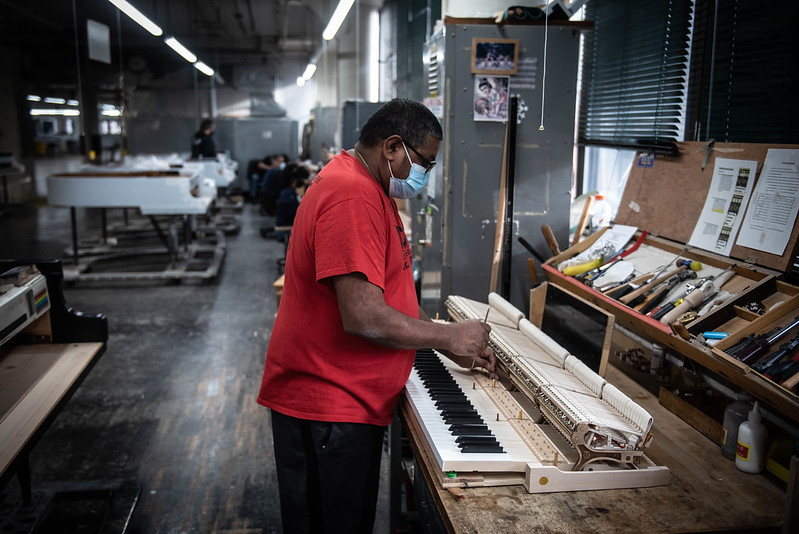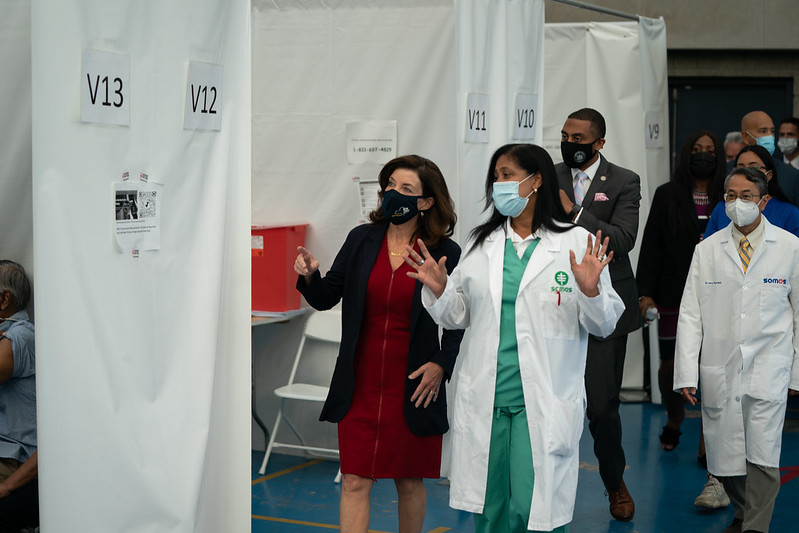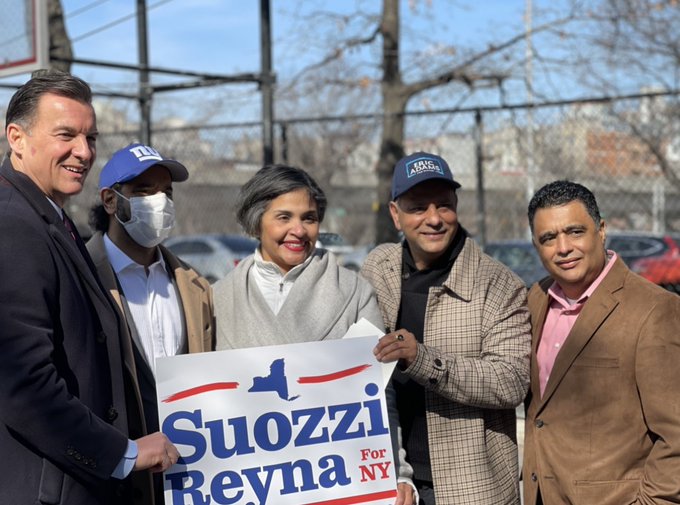An Inclusive Economic Recovery Will Prevent Crime

On the job (photo: Michael Appleton/Mayoral Photography Office)
Roughly a decade has passed since New York City experienced crime rates and unemployment rates as high as they are today. That is no coincidence: although crime has many contributing factors, joblessness is a primary cause.
While we need immediate interventions to stop violence now, the best antidote to crime in the long run is a growing and inclusive economy. That is why, as New York recovers from the pandemic, we must invest in workforce development programs that give our young people the chance to choose careers over crime.
This issue is personal for me. Growing up as the son of two community street vendors in Washington Heights, I watched some of my peers make decisions that had a devastating impact for themselves and others. And so, after becoming a first-generation university graduate and receiving my Master in Social Work, I came back to Inwood and Washington Heights to work with at-risk youth.
But today, these communities—and other communities like them—are facing persistent joblessness. Before covid struck, roughly one-in-ten workers in Washington Heights and Inwood worked in a restaurant. With the overall restaurant workforce still 30% below pre-pandemic levels, too many men and women remain out of a job. Other low-wage workers, like those who used to be employed in midtown office buildings, may not see their jobs return for years.
This leaves too many unemployed people, including our youth, looking for some way—any way—to earn a living. Providing these jobless workers with the skills and opportunity to participate in the post-pandemic economy is critical to warding off future violence in our communities.
What we need now is a generational investment in workforce development programs that is guided by three fundamental principles to ensure their success.
First, we must adopt a people-centered approach to workforce development. New York’s current program-centered approach funds a laundry list of initiatives and asks people to navigate their way through them. As a social worker, I know that far too often people fall through the cracks. A people-centered approach would identify unemployed workers and at-risk youth early, understand their needs, and then move them seamlessly from skills-development programs through to job placement.
Second, we must scale up workforce development approaches that we know work. Some of the best workforce development programs in the country were started here in New York City.
For example, Per Scholas—a program that trains young people from low-income families to enter the tech industry—started in the Bronx and has a proven track record of boosting the livelihoods of its graduates. Rather than spreading funding thin across a hodgepodge of programs, New York should invest in expanding programs that succeed.
Third, we must build new partnerships to drive workforce development in our communities. This means partnering with unions, universities, colleges, and businesses so that workforce development programs prepare people for the jobs of today. In addition, we should explore proposals from places like the Center for an Urban Future and Jobs First NYC that would bring real-estate developers to the table so that they contribute to workforce and economic development in the communities where they own buildings.
Of course, a smarter approach to workforce development will be meaningless unless backed by serious cash. That is why I will fight to ensure that Governor Hochul’s budget request for $350 million for workforce development is fully funded in the next state budget.
And, that is why I strongly support Mayor Adams’ recent announcement that New York City will support 100,000 summer job opportunities for young people. When necessary, I will fight for more state money to support initiatives like this. But I will also stand as a watchdog to ensure that those funds are spent wisely so that our young people benefit.
Mayor Adams is fond of quoting the wise words of the recently deceased Archbishop Desmond Tutu: “We need to stop just pulling people out of the river. We need to go upstream and find out why they're falling in.”
Having grown up in Washington Heights and Inwood, and after a career working with at-risk youth in my community, I too am tired of pulling people out of the river. If we make meaningful investments in workforce development today, we can finally limit the number of them falling into the river in the first place.
***
Manny De Los Santos was recently elected to the New York State Assembly to represent the 72nd Assembly District, which includes Washington Heights, Inwood, and Marble Hill. On Twitter @AMDeLosSantos72.
***
Have an op-ed idea or submission for Gotham Gazette? Email This email address is being protected from spambots. You need JavaScript enabled to view it.
New York Needs to Protect Medicaid Members in the State Budget

Good health care is essential (photo: Don Pollard/Governor’s Office)
More than 5.5 million New Yorkers rely on Medicaid managed care health plans for their care. Many of these members are among the state’s most at-risk residents, with multiple health conditions that require coordination of numerous services. This includes both physical health and mental health care, long-term services and supports, as well as help coordinating social services, such as housing, employment, education, and food access. They often rely on Alzheimer’s Disease Resource Center (ADRC) and other community-based organizations to help them navigate the health-care system and access the care and services they need.
Unfortunately, a provision in Governor Hochul’s proposed state budget for the upcoming fiscal year will take away choices from patients, create havoc in the delivery system, and undercut efforts to promote health equity.
The proposal would direct the Department of Health to reduce the number of health plans in the Medicaid program to no fewer than two but no more than five in each region of the state. Hundreds of thousands of individuals will be forced out of their current plan, disrupting their care and potentially forcing them to switch providers.
As an organization that provides care, support and education to families facing Alzheimer’s disease and other dementias, we’re concerned that it will make it harder for the people we serve to get the services they need. If their current plan is eliminated, the disruption in care will also impact the families who are already often overwhelmed with their caregiving responsibilities.
The proposal also runs counter to the state’s goal of promoting health equity. Underserved populations, including communities of color, have been disproportionately affected by the pandemic. Taking options away from Medicaid members doesn’t just threaten the ability of providers to support their patients but will undercut efforts to address racial and ethnic disparities in care. While New York’s Medicaid program has been a national leader in improving quality and health-care outcomes, the challenges this proposal will cause to coordinate care has the potential to threaten those efforts.
Despite the health and economic impact of the pandemic on the state, New York’s uninsured rate dropped to less than 5%. Medicaid has played an important role in providing a safety net in the middle of a global health crisis. Unfortunately, the governor’s proposal will take away resources from other important health priorities.
For example, as the public health emergency ends the state will have to recertify eligibility for every Medicaid member. Taking options away from patients will make it harder to ensure that low-income individuals stay covered as they try to navigate these changes.
It is more important than ever to protect the choices available for vulnerable New Yorkers who rely on the Medicaid program. The state should not make it more difficult for New Yorkers with complex health conditions to get the care they need. Considering the level of disruption the proposal will cause for patients and providers, the governor and Legislature should drop this policy proposal from the state budget that is due by April 1.
***
Robin Marks is Executive Director of Alzheimer’s Disease Resource Center. On Twitter @adrcinc.
***
Have an op-ed idea or submission for Gotham Gazette? Email This email address is being protected from spambots. You need JavaScript enabled to view it.
Latinos and the 2022 Democratic Primary

Suozzi-Reyna (photo: @Reyna4NY)
The Latino vote in New York is, thankfully, becoming the important point of conversation it should be. While there’s a ways to go, there is more discussion happening -- including a variety of political debates, via the inimitable work of Errol Louis in one of his recent columns as well as a podcast episode he dedicated to the Latino vote with me as his guest, and through this series of pieces and associated podcasts published by Gotham Gazette, among other sources.
I have sought to explicate the intricacies of this burgeoning ethnic group for a number of years, largely through this platform. Despite the increased attention, Latinos seem to still often be an afterthought for many elected and party officials, as was made evident by the recent selection of speakers at last month’s state Democratic convention. No Latinos were on the original list of speakers, and it was only after a number of prominent Latinos complained about the snub that party officials scrambled to include three Latinos on the list.
Snubbed or not, disregarded or not, Latinos are and will continue to be an important voting constituency in New York City and State elections. Some politicians understand this, like Tom Suozzi, a member of Congress who is now aspiring to defeat Governor Kathy Hochul and others in June’s Democratic primary. Suozzi not only named former Bronx Borough President Fernando Ferrer the chair of his campaign; he also named Diana Reyna, former City Council member and deputy Brooklyn Borough President, as his lieutenant governor running-mate.
New York City Public Advocate Jumaane Williams, also running for the Democratic nomination for Governor, and his supporters in the Working Families Party also appear to be aware of the importance of the Latino vote, as they recruited Ana Maria Archila to run for Lieutenant Governor as Williams’ running-mate. (Candidates for governor and lieutenant governor are not linked on the primary ballot, but they often present themselves to voters as running-mates.)
Will Latinos play a key role in who wins the governorship this year? Will Latinos defy previous voting patterns and turn out to vote in larger numbers?
The answer to the first question is a clear yes. The second question is more complicated, and my answer will come in the form of a challenge.
According to my analysis of voter rolls, Latinos are currently 18% of the entire state Democratic electorate, with 1,152,950 voters across the Empire State. This 18% represents the largest share of Latino Democratic voters in state history. Of the 1.15 million Latino voters, 862,255 are in New York City. That is a whopping 75% of the Latino electorate in the five boroughs.
Hence, any statewide candidate who does not visit the storefront cuchifritos in East Harlem or devour the excellent mangus at establishments in Washington Heights and the Bronx or stop by the taquerias in Sunset Park and visit the tree-lined streets of Corona and Elmhurst, will do so at their own peril.
Voter registration numbers, however, are not necessarily the equivalent of voting power. Voting power for Latinos will come once Latinos recognize that proper political representation and adequate policy attention to their plight can only come through robust and consistent voting participation.
As for proper representation, its lack is evident given the fact that among state legislators in New York City, only 17% are Latino, though Latinos represent 29% of the entire city population.
While Latinos continue to increase in the voting population, the fact remains that only 14% of the entire Democratic electorate in the last gubernatorial primary was Latino. To be sure, the low turnout rates among Latinos is not a dilemma unique to New York, as I have mentioned here before. Yet the dilemma is here and must be dealt with.
On a more positive note, that 14% in 2018 was an increase compared to previous years, and even more importantly, since that last gubernatorial primary, Latino voting participation in New York City has already increased by 4% in the 2020 and 2022 primaries.
If the patterns of the last few years continue, I can foresee a scenario in which close to 250,000 Latinos could turn out statewide to vote in this June’s Democratic primary. This would represent the largest ever turnout among Latinos in New York.
What can contribute to this potential increase of Latino voters?
One potential for increased Latino voting participation could lie in the fact that there could be two Latinas on the ballot for lieutenant governor, Reyna and Archila. Having two Latinas vying for the same position -- against incumbent Lt. Gov. Brian Benjamin -- may not be the most conducive to success for their respective candidacies. Such a scenario pits two Latinas against each other, potentially splitting the Latino vote for this position. Yet the Archila and Reyna candidacies can be a potential boon for Latino voting participation, provided that their campaigns invest enough resources (money, time, personnel) in Latino communities.
Archila’s and Reyna’s candidacies could be a bigger boost for Latino voters than the candidates at the top of the ballot—expected to include Hochul, Suozzi, and Williams, to name the top tier.
Previous studies point to increased voting among Latinos when viable Latino candidates are on the ballot. The well-respected Latino political scientist Matt Barreto, with Mario Villareal and Nathan Woods for instance, have studied Latino voting patterns in high density Latino precincts in California and observed that the highest Latino turnout rates in Los Angeles occurred when a Latino was at the top of the ballot for mayor, both within the nonpartisan primaries and in the general elections.
I have used an analysis like Barreto’s to investigate Latino voting patterns in New York and have also found that Latino voting participation has increased when a viable Latino has been at the top of the ballot.
When observing Fernando Ferrer’s candidacy for mayor of New York City in 2001, I noted an increase in voter participation within the New York precincts with the highest Latino populations in comparison with other mayoral primaries when a viable Latino was not on the ballot. In fact, voter participation in heavily Latino precincts increased an average of 30-40% in 2005, when Ferrer became the first Latino to win a Democratic mayoral primary, compared to years with no Latino candidate at the top of the ballot.
While the position of lieutenant governor is not atop the ballot, it still is a position of importance (though not so much in the day-to-day practical operations of state government), as is evident in the Cuomo saga and the eventual rise of Kathy Hochul to the governorship. This election cycle may be the first time that viable Latino candidates will appear on the ballot for a statewide position. And for this reason, provided that the Williams-Archila and Suozzi-Reyna tickets invest in the Latino vote, there is real potential for an increase in Latino voting participation.
What role might the Kathy Hochul-Brian Benjamin ticket have in bringing out the Latino vote this June? Up to this point, I have not seen the necessary investment on the part of Governor Hochul or the state Democratic Party apparatus in the Latino vote as a possible motivating factor for an increase in Latino voting participation. Outside of a few Latino appointments, and some holdovers from the Cuomo administration, Governor Hochul has not done much to increase Latino representation in state government.
At the time of this writing, only 5 of the 16 Latino New York City based state legislators have endorsed Hochul’s candidacy. Only two Latino New York City Council members have endorsed Hochul. And I have already noted how the state Democratic Party snubbed Latinos at its recent convention.
It may take two Latinas -- Archila and Reyna -- to help wake the sleeping giant that is the Latino vote in New York. It will of course take many others to contribute to the rise of Latinos in New York, but perhaps a lot more rests upon the shoulders of Archila and Reyna than they might think.
***
Eli Valentin is an adjunct lecturer at Union Theological Seminary. He writes regular columns for Gotham Gazette, largely focused on Latino politics in New York City, and is a frequent guest political analyst at Univision NY. On Twitter @EliValentinNY.




